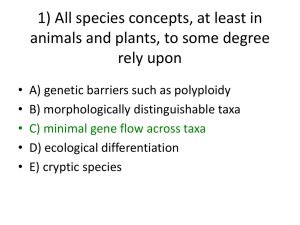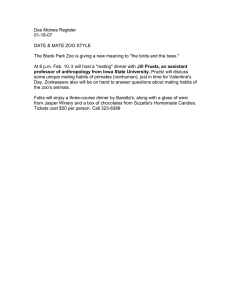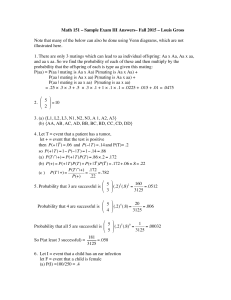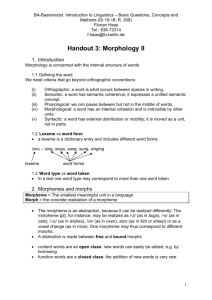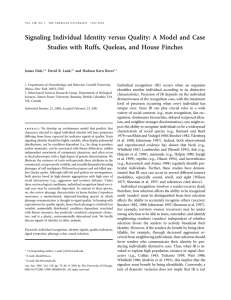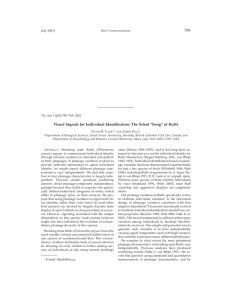Reflections Di erse processes maintain plumage polymorphisms in birds
advertisement
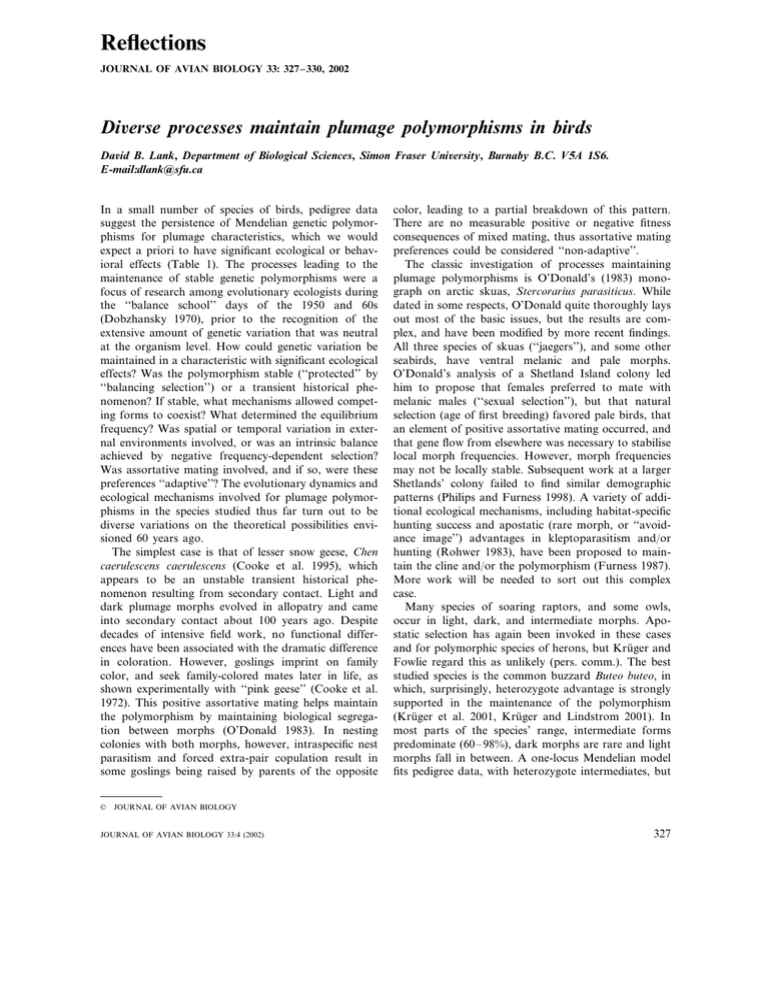
Reflections JOURNAL OF AVIAN BIOLOGY 33: 327–330, 2002 Di7erse processes maintain plumage polymorphisms in birds Da7id B. Lank, Department of Biological Sciences, Simon Fraser Uni7ersity, Burnaby B.C. V5A 1S6. E-mail:dlank@sfu.ca In a small number of species of birds, pedigree data suggest the persistence of Mendelian genetic polymorphisms for plumage characteristics, which we would expect a priori to have significant ecological or behavioral effects (Table 1). The processes leading to the maintenance of stable genetic polymorphisms were a focus of research among evolutionary ecologists during the ‘‘balance school’’ days of the 1950 and 60s (Dobzhansky 1970), prior to the recognition of the extensive amount of genetic variation that was neutral at the organism level. How could genetic variation be maintained in a characteristic with significant ecological effects? Was the polymorphism stable (‘‘protected’’ by ‘‘balancing selection’’) or a transient historical phenomenon? If stable, what mechanisms allowed competing forms to coexist? What determined the equilibrium frequency? Was spatial or temporal variation in external environments involved, or was an intrinsic balance achieved by negative frequency-dependent selection? Was assortative mating involved, and if so, were these preferences ‘‘adaptive’’? The evolutionary dynamics and ecological mechanisms involved for plumage polymorphisms in the species studied thus far turn out to be diverse variations on the theoretical possibilities envisioned 60 years ago. The simplest case is that of lesser snow geese, Chen caerulescens caerulescens (Cooke et al. 1995), which appears to be an unstable transient historical phenomenon resulting from secondary contact. Light and dark plumage morphs evolved in allopatry and came into secondary contact about 100 years ago. Despite decades of intensive field work, no functional differences have been associated with the dramatic difference in coloration. However, goslings imprint on family color, and seek family-colored mates later in life, as shown experimentally with ‘‘pink geese’’ (Cooke et al. 1972). This positive assortative mating helps maintain the polymorphism by maintaining biological segregation between morphs (O’Donald 1983). In nesting colonies with both morphs, however, intraspecific nest parasitism and forced extra-pair copulation result in some goslings being raised by parents of the opposite © color, leading to a partial breakdown of this pattern. There are no measurable positive or negative fitness consequences of mixed mating, thus assortative mating preferences could be considered ‘‘non-adaptive’’. The classic investigation of processes maintaining plumage polymorphisms is O’Donald’s (1983) monograph on arctic skuas, Stercorarius parasiticus. While dated in some respects, O’Donald quite thoroughly lays out most of the basic issues, but the results are complex, and have been modified by more recent findings. All three species of skuas (‘‘jaegers’’), and some other seabirds, have ventral melanic and pale morphs. O’Donald’s analysis of a Shetland Island colony led him to propose that females preferred to mate with melanic males (‘‘sexual selection’’), but that natural selection (age of first breeding) favored pale birds, that an element of positive assortative mating occurred, and that gene flow from elsewhere was necessary to stabilise local morph frequencies. However, morph frequencies may not be locally stable. Subsequent work at a larger Shetlands’ colony failed to find similar demographic patterns (Philips and Furness 1998). A variety of additional ecological mechanisms, including habitat-specific hunting success and apostatic (rare morph, or ‘‘avoidance image’’) advantages in kleptoparasitism and/or hunting (Rohwer 1983), have been proposed to maintain the cline and/or the polymorphism (Furness 1987). More work will be needed to sort out this complex case. Many species of soaring raptors, and some owls, occur in light, dark, and intermediate morphs. Apostatic selection has again been invoked in these cases and for polymorphic species of herons, but Krüger and Fowlie regard this as unlikely (pers. comm.). The best studied species is the common buzzard Buteo buteo, in which, surprisingly, heterozygote advantage is strongly supported in the maintenance of the polymorphism (Krüger et al. 2001, Krüger and Lindstrom 2001). In most parts of the species’ range, intermediate forms predominate (60– 98%), dark morphs are rare and light morphs fall in between. A one-locus Mendelian model fits pedigree data, with heterozygote intermediates, but JOURNAL OF AVIAN BIOLOGY JOURNAL OF AVIAN BIOLOGY 33:4 (2002) 327 328 Table 1. Selected attributes of some plumage polymorphic bird species. See text for species references. JOURNAL OF AVIAN BIOLOGY 33:4 (2002) Species Plumage polymorphism Geographic segregation Poly-morphic sex(es) Genetic system Fitness of morphs Behavioral differences Mating system Functional significance Snow goose White vs. dark, intermediates Yes M and F Inc. dom. = Minimal Positive assortative pairs, due to imprinting? None? Arctic skua Light, dark, intermediates North–south M and F cline Inc. dom. =or clinal? Different life histories? Habitat-specific hunting success, timing of breeding? Positive assortative pairs, due to imprinting? Climate, habitat, sexual selection? Buzzards Light, dark, intermediate In part M and F Inc. dom. Int. \light\ dark Intraspecific competitive ability for territories and mates Pairs – ‘‘maladaptive’’ mating? ??? White-throated sparrow White vs. tan eye stripe No M and F Dom-rec Similar Parental care, extra-pair fertilization rates, habitat preferences Negative-assortative Signal behavioral pairs, extra-pair morph for neg. fertilizations assortative mating asymmetrical by morph Red-billed quelea White, black facial mask, yellow, red body colors In part M Highly heritable, no formal model = Minimal, if any Random pairs? Individual identity signaling Ruffs Individual variation, ranges vary with behavioral morph No M Not modeled, correlated behavior dimorphism is dom-rec. Similar, different life histories? Male mating strategy on lek lek+polyandry, active diversification? Individual identity signaling, signal behavioral. morph Paradise flycatcher White vs. rufous No M ??? = ???1 different life histories? Whites sing more1 ??? ??? 1 R. Mulder, pers. comm. there is also sufficient individual variation to allow humans, and presumably buzzards, to distinguish individuals (see below). At a single well-studied site, heterozygotes achieve substantially higher breeding success and survivorship than light or dark morphs. Heterozygote advantage (‘‘heterosis’’) is a well-established potential mechanism for maintaining polymorphisms, but should select strongly for modifiers that prevent the continual regeneration of less fit genotypes, unless pleiotropic effects at other loci are involved, as in the classical case of sickle-cell anaemia in humans. Even more remarkably, familial imprinting appears to operate, which often leads to apparently ‘‘maladaptive’’ mate choice decisions, although these may be the best possible if self-recognition does not occur (Fowlie, pers. comm.). If the data from one area are at all applicable to other populations, why this species genetic system does not evolve towards monomorphism remains enigmatic. White-throated sparrows Zonotrichia albicollis occur in two color morphs, having tan or white eye stripes. The primary mechanism maintaining this polymorphism is strong negative assortative mating between the two morphs, unique among birds. This is also the only species in which we have a clear genetic marker: white striped birds have a dominant pericentric inversion on chromosome 2 (Thornycroft 1975). Numerous behavioral differences correlate with plumage morph, including the extent of extra-pair mating behavior (Tuttle in press). Ninety-five percent of pairs are mixed-morph. Negative assortment assures similar reproductive success for pair members of both morphs, and the population consists of ca. half heterozygotes, which are white, and half homozygous recessives. This type structure is the predicted equilibrium if one homozygote is more fit than another (Falk and Li 1969), and the double inversion ‘‘white–white’’ may be nearly lethal, as few if any have been discovered. Although the underlying behavioral and ecological mechanisms are still unclear, we can at least state that negative assortative mating stabilises this system towards an intrinsic equilibrium. Three species in which plumage polymorphism is restricted to males have been studied, and the mechanisms invoked to account for these center on negativefrequency dependent fitness. Male red-billed quelea Quelea quelea vary continuously in the colors of facial masks (white to brown to black) and head and upper body color (yellow to red). Geographic variation does occur in this highly abundant species, however within all populations, overall plumage variability is high. As with snow geese, no directional functional differences have been associated with morph type (Dale 2000). Instead, multiple independent plumage polymorphisms combine to produce properties consistent with a specially evolved signal of individual identity. Such a polymorphism should be maintained through negative frequency dependence, through advantages accrued by JOURNAL OF AVIAN BIOLOGY 33:4 (2002) individuals that are the most recognizable (Dale et al. 2001). Since females do not express the characteristics, we have no data on assortative mating, however an unusually strong correlation between father and son plumage colour suggests that positive assortative mating is likely (Dale 2000). In male ruffs Philomachus pugnax, plumage variation has been taken to an avian extreme, but the mechanism involved may be similar to that proposed for queleas. Each male molts into ornamental and body feathers individually distinctive in color and pattern. Plumage manipulation experiments prove that males distinguish other males based on color pattern (Lank et al. unpubl. data). Hypervariability in breeding plumage may occur because males’ social displays are silent, thus auditory recognition of individual identity, used by many other species of birds, does not occur (Lank and Dale 2001). Ranges of colors correlate strongly with a behavioral dimorphism; male ruffs either defend lek mating courts against other territorial males, or share courts with non-territorial ‘‘satellite’’ males (Hogan-Warburg 1966). The behavioral difference is attributable to an autosomal genetic dimorphism (Lank et al. 1995, 1999), and strong pedigree effects on plumage also exist (Lank and Smith unpubl. data). The behavioral dimorphism appears to be intrinsically stabilised by females preferring to mate when both types of males are present on a court (Hugie and Lank 1997, Widemo 1998). The plumage variability within behavioral morphs may have evolved to signal individual identity, as with quelea (Dale et al. 2001). Females’ diversify their mate choices with respect to behavioral morph (Lank et al. 2002), which may also help maintain the plumage polymorphism. We now add to this list Madagascar paradise flycatchers Terpsiphone mutata (Mulder et al. 2002) and congeners T. paradisi and T. 6iridis, although pedigree data are thus far lacking. Adult males of these species occur as black and white or mostly rufous morphs, in ratios of about 2:1. No obvious geographical clines occur. The morphs differ substantially in plumage ontogeny. White males achieve their definitive plumage at age 3, while rufous males take up to 6 yrs to do so. This implies a strong difference in male life history patterns. No balancing mechanism has yet been proposed to account for the polymorphism, although behavioral differences in song rate have been reported. One possibility is suggested by studies of disruptive selection on juvenile plumage patterns of indigo buntings (Greene et al. 2000). Young males have a bimodal distribution of breeding plumage coloration. Bright young males obtain lower quality, isolated territories, and raise fewer young than their dull counterparts. Dull males obtain better territories, adjacent to high quality territories occupied by adults, but lose substantial paternity to their neighbors, resulting in similar annual success and disruptive selection on juvenile morph. Might younger 329 paradise flycatcher males make similar tradeoffs? We eagerly await further elucidation and description of the ecological mechanisms and evolutionary dynamics of this system. The small number of cases studied thus far cover a large part of the range of possibilities outlined by the balance school population geneticists. Snow geese have an unstable transient polymorphism, variation in the skuas probably reflects an ecological fitness cline, the buzzards demonstrate heterozygote advantage, the white-throated sparrows are maintained by negative assortative mating, ruffs and queleas polymorphism suggest negative frequency dependent processes. One mechanism missing is temporally oscillating or otherwise shifting advantages. Despite the rich diversity of mechanisms maintaining these conspicuous polymorphisms, they remain rare. Direction or normalizing selection leading towards monomorphism seems a simpler process than diversifying selection, favoring polymorphisms. While maintaining such conspicuous variation is not just a theoretical possibility, as these cases demonstrate, they remain the exception rather than the rule in natural systems. Acknowledgements – Table 1 was largely generated at lunch discussions at the International Society for behavior Ecology meeting in Montreal, including J. Dale, V. Formica, M. Fowlie, O. Krüger, R. Mulder and E. Tuttle. References Cooke, F., Rockwell, R. F. and Lank, D. B. 1995. The snow geese of La Pérouse Bay: natural selection in the wild. – Oxford Univ. Press, Oxford. Cooke, F., Mirsky, P. J. and Seiger, M. B. 1972. Colour preferences in the lesser snow goose and their possible role in mate selection. – Can. J. Zool. 50: 529 – 536. Dale, J. 2000. Ornamental plumage does not signal male quality in red-billed queleas. – Proc. R. Soc. Lond. B 267: 2143 – 2149. Dale, J., Lank, D. B. and Reeve, H. K. 2001. Signaling individuality vs. quality: a model and case studies with ruffs, queleas and house finches. – Am. Nat. 158: 75 – 86. Dobzhansky, T. 1970. Genetics of the evolutionary process. – Columbia Univ. Press, New York. 330 Falk, C. T. and Li, C. C. 1969. Negative assortative mating: exact solution to a simple model. – Genetics 62: 215 – 223. Furness, R. W. 1987. The skuas. – T & A D Poyser, Calton, Staffordshire. Greene, E., Lyon, B. E., Muehter, V. R., Ratcliffe, L., Oliver, S. J. and Boag, P. T. 2000. Disruptive sexual selction for plumage coloration in a passerine bird. – Nature 407: 1000 – 1003. Hogan-Warburg, A. J. 1966. Social behaviour of the ruff, Philomachus pugnax. – Ardea 54: 108 – 229. Hugie, D. M. and Lank, D. B. 1997. The resident’s dilemma: a female-choice model for the evolution of alternative male reproductive strategies in lekking male ruffs (Philomachus pugnax). – Behav. Ecol. 8: 218 – 225. Krüger, O. and Lindstrom, J. 2001. Lifetime reproductive success in common buzzard Buteo buteo: from individual variation to population demography. – Oikos 93: 260 – 273. Krüger, O., Lindstrom, J. and Amos, W. 2001. Maladaptive mate choice maintained by heterozygote advantage. – Evolution 55: 1207 – 1214. Lank, D. B. and Dale, J. 2001. Visual signals for individual identification: the silent ‘‘song’’ of Ruffs. – Auk 118: 759 – 765. Lank, D. B., Smith, C. M., Hanotte, O., Burke, T. A. and Cooke, F. 1995. Genetic polymorphism for alternative mating behaviour in lekking male ruff, Philomachus pugnax. – Nature 378: 59 – 62. Lank, D. B., Coupe, M. and Wynne-Edwards, K. E. 1999. Testosterone-induced male traits in female ruffs (Philomachus pugnax): autosomal inheritance and gender differentiation. – Proc. R. Soc. Lond. B 266: 2323 – 2330. Lank, D. B., Smith, C. M., Hanotte, O., Ohtonen, A., Bailey, S. and Burke, T. 2002. High frequency of polyandry in a lek mating system. – Behav. Ecol. 13: 209 – 215. Mulder, R. A., Ramiarison, R. and Emahalala, R. E. 2002. Ontogeny of male plumage dichromatism in Madagascar paradise flycatchers. – J. Avian Biol. 33: 00 – 00. O’Donald, P. 1983. The Arctic skua. – Cambridge Univ. Press, Cambridge. Philips, R. A. and Furness, R. W. 1998. Polymorphism, mating preferences and sexual selection in the Arctic skua. – J. Zool. Lond. 245: 245 – 252. Rohwer, S. 1983. Formalizing the avoidance-image hypothesis: critique of an earlier prediction. Thornycroft, H. B. 1975. A cytogenetic study of the whitethroated sparrow Zonotrichia albicollis. – Evolution 29: 611 – 621. Tuttle, E. M. Alternative reproductive strategies in the whitethroated sparrow: behavioral and genetic evidence. – Behav. Ecol. in press. Widemo, F. 1998. Alternative reproductive strategies in the ruff Philomachus pugnax: a mixed ESS? – Anim. Behav. 56: 329 – 336. JOURNAL OF AVIAN BIOLOGY 33:4 (2002)

